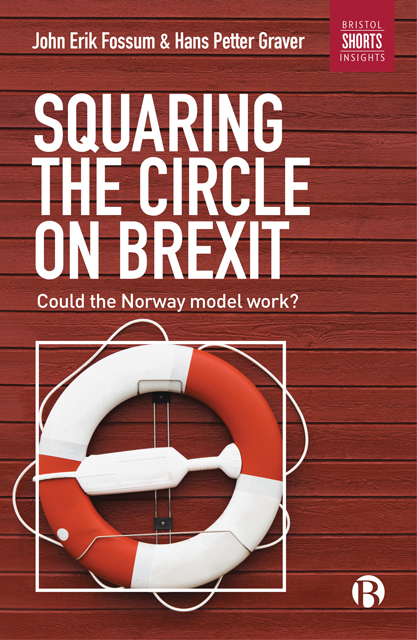Book contents
- Frontmatter
- Contents
- Foreword
- Preface and acknowledgements
- List of abbreviations
- Introduction
- 1 What does Britain want from Brexit?
- 2 Forms of affiliation with non-members
- 3 What is the Norway model?
- 4 The challenge of sovereignty
- 5 What can Britain learn from Norway’s experience?
- 6 Would Britain be an ‘elephant in the boat’?
- Conclusion
- Notes
- References
- Appendix
- Index
1 - What does Britain want from Brexit?
Published online by Cambridge University Press: 21 April 2023
- Frontmatter
- Contents
- Foreword
- Preface and acknowledgements
- List of abbreviations
- Introduction
- 1 What does Britain want from Brexit?
- 2 Forms of affiliation with non-members
- 3 What is the Norway model?
- 4 The challenge of sovereignty
- 5 What can Britain learn from Norway’s experience?
- 6 Would Britain be an ‘elephant in the boat’?
- Conclusion
- Notes
- References
- Appendix
- Index
Summary
This chapter focuses on the UK’s objectives in relation to Brexit, with emphasis on the role and salience attributed to the Norway model. The post-referendum UK government has quite consistently rejected a future UK‒EEA membership as part of its rejection of all off-the-shelf agreements (a relationship that the EU already has with at least one non-member state and which can be extended to include the UK), and has instead stressed the need for a set of bespoke agreements with the EU (a set of agreements that are specially designed for the UK). Views across the UK differ widely on the preferred form of the UK’s future EU association, and the government has been widely criticised for lack of clarity and realism. The government’s position has then also shifted considerably over time. The 8 December 2017 Withdrawal Agreement shows how it has conceded to the EU on substantive issues and on control of the process. It now acknowledges that there is a need for a period of transition. Close to a year after the negotiations began, it remains unclear what the UK government wants and what it will settle for.
In order to untangle this, we need to consider: (a) the type of future EU association the UK government expresses a commitment to (whatever the details may be), and how it has evolved; (b) those actors and forces that influence this, what they want and how influential they are; (c) who controls the Brexit process (if anyone); and (d) the broader (European and global) context within which this process is unfolding. The unfolding of the Brexit saga thus far suggests that the UK’s future relationship with the EU will be determined not by goal-driven government action, but by a complex and unwieldly process that is influenced by a broad range of actors and factors.
The chapter is divided into two main sections. In the first, we consider the position of the UK government, which asserted that ‘Brexit means Brexit’ in line with the Leave camp’s focus on the need for taking back control. In the second section, we consider how this objective is to be carried out by paying attention to those UK actors that are most capable of influencing the course of action. Our survey includes parliament and political parties; devolved nations (the Scottish government’s view, that of Wales and that of Northern Ireland); business; and labour unions.
- Type
- Chapter
- Information
- Squaring the Circle on BrexitCould the Norway Model Work?, pp. 1 - 26Publisher: Bristol University PressPrint publication year: 2018



